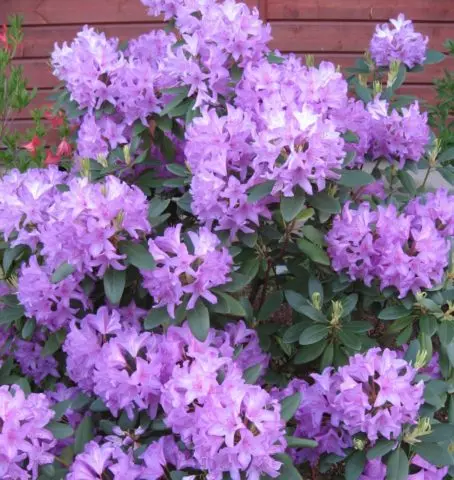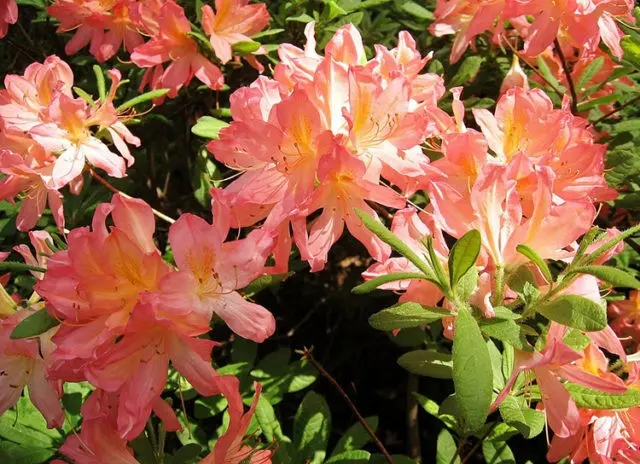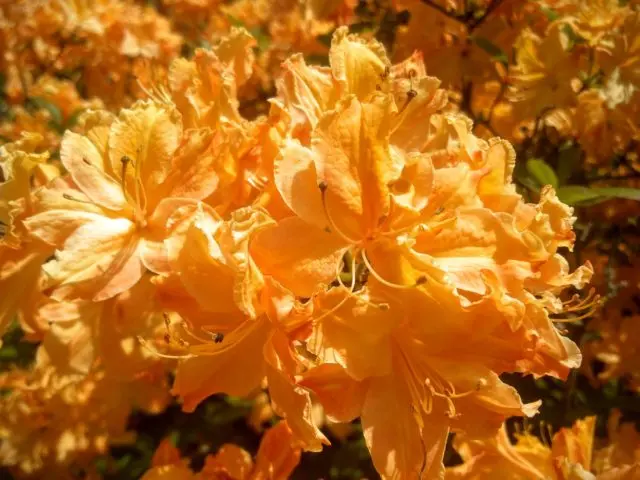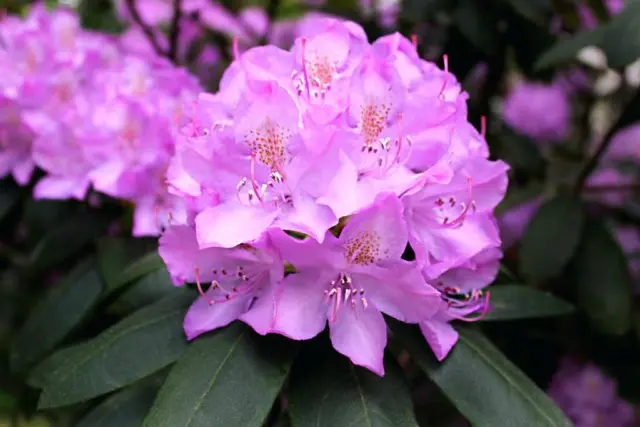Contents
Planting and caring for rhododendrons in the Urals is possible when choosing the right variety and quality shelter for the winter. When choosing a variety, it is important to consider not only its frost resistance, but also the flowering time. Varieties blooming in April are not suitable for cultivation in the Urals. Also, deciduous rhododendrons are more winter hardy than evergreen species.
How to grow rhododendrons in the Urals
Rhododendron in the Urals is grown for the high decorative qualities of the shrub. But the culture has its own characteristics: a small annual increase, demanding care and participation of the gardener throughout the year.
For abundant flowering of rhododendron in the Urals, it is necessary to choose a suitable place, stock up on an acidic substrate, carry out even watering and top dressing.
An important condition for growing an ornamental shrub in the Urals is its shelter for the winter: both from frost and from the drying effects of wind and sun. The biological feature of the rhododendron is that the flower buds of the next year are formed at the end of the current season. If the buds do not persist in the winter, there will be no flowering in the new season.
Varieties of rhododendron for the Urals
Rhododendrons are divided into evergreen, semi-deciduous and deciduous. Frost-resistant rhododendrons for the Urals are characterized by increased acclimatization to a cold climate.
Grandiflorum – one of the old varieties created on the basis of the Katevbinsky rhododendron. Refers to evergreen species. The bush is strongly branched, grows spreading and tall – up to 4 m. One of the most beautifully flowering shrubs. The flowers are lilac in color, on the upper petal there are bright orange blotches. The flowers grow 6-7 cm in diameter, collected in inflorescences of 13-15 pcs. The stamens are long and curved. The flowers have no fragrance. Grandiflorum blooms in June. Withstands frosts down to -32°C.

Japanese – unpretentious highly ornamental shrub. It forms a dense, branched bush, up to 1,8 m high. Japanese rhododendron belongs to deciduous shrubs. It blooms for a month from the end of spring, at the same time leaves bloom on the bush. Flowers have a pleasant aroma. Large ones grow – about 8 cm in diameter, 7-10 pieces are collected in the inflorescence. They have various shades of orange, red and beige-yellow. Flowering begins after 3-4 years of cultivation.

Rhododendrons of the Lights series – American selection of one of the most frost-resistant rhododendrons. Withstand frosts down to -40°C. The shrub is deciduous, grows up to 150 cm high, 130-150 cm wide. The crown is dense, spreading in most varieties. Branches grow straight. The leaves are broad, ovate or oblong, large. Depending on the variety, shiny, leathery or slightly pubescent.
The leaves are olive green in summer, turning to burgundy in autumn. Flowering begins in late spring. Variety shades are varied:
- white, white-yellow;
- light pink, pink;
- salmon;
- tangerine.
The flowers are simple or semi-double, 5-6 cm in size. Inflorescences are spherical, unite 10-15 flowers.

Helsinki University – an evergreen rhododendron belonging to the Finnish selection. It forms a spherical crown, 1-1,5 m high. Flowering begins in mid-June and lasts 2-3 weeks. The flowers are pale pink with an orange center and maroon blotches. The size of the flowers in diameter is 7-8 cm, collected in inflorescences of 12-15 pcs. The variety is exceptionally hardy, withstands temperatures as low as -39°C.

Roseum Elegance – an evergreen shrub bred in England. The bush grows spreading up to 3 m in height and 3,5 m in width, forms a rounded crown shape. The leaves are leathery, glossy, in the form of an elongated oval of medium size. Young leaves have a red-brown hue when blooming, turning into green as they grow. The flowers are deep pink with a reddish-brown spot. The shape of the flower is wide-funnel-shaped with a wave along the edge. Inflorescences are compact, unite 15 flowers. Flowering begins in early June. The aroma is absent. Withstands frosts down to -32°C.

Planting rhododendron in the Urals
In the photo of rhododendrons in the Urals, you can see that when planted in a suitable place and properly cared for, ornamental shrubs become long-livers in the garden. They can grow in a permanent place for more than 30 years. Some types of rhododendron are grown in large containers and transferred indoors in winter.
In the open field, rhododendrons in the Urals are planted in a diffuse shade or a place where they are illuminated by the sun for only a few hours a day. Flowers of some varieties fade and fade in the bright sun. Deciduous species require more sunlight than evergreens.
Terms of planting
Rhododendron planting in the Urals is carried out in the spring, but before the plant awakens. It is permissible to plant seedlings with a closed root system at any time of the warm season, excluding the moment of flowering and a few weeks after it.
Site preparation
The place for growing rhododendron in the Urals is chosen carefully. It is necessary to take into account the size of the bush in adulthood, the requirement of the variety for shading and the proximity of crops. Do not plant rhododendron next to trees with the same superficial root system. Large trees will take on a lot of nutrition and moisture, they can grow inside the root system of the rhododendron, damaging it.
The soil in the planting area should be acidic. In another reaction, the soil layer is changed to a suitable one. It is best to grow ornamental shrubs in groups with crops that are similar in terms of soil acidity requirements. In coniferous corners, rhododendrons are combined with thujas, junipers, and hosts. The distance between individual species is observed at 0,7-1 m.
Rules of landing
In the photo and video about the care and planting of rhododendrons in the Urals, you can see that they do not differ from agricultural technology in other regions. The root system of the rhododendron is superficial and grows more in width than in depth, so the planting hole is made spacious, but shallow.
A place for growing in the Urals should conduct moisture well, be free of stagnation. Therefore, a drainage layer is poured at the bottom of the pit, 20 cm high. White broken bricks are not used as drainage because of its unsuitable composition. It is better to use pebbles or expanded clay.

On clay soils, you should first check the drainage by pouring water into the pit. Due to the poor conductivity of clay soil, a well may form in the planting hole to drain water from the site. If the water does not leave for a long time when testing the drainage, the landing site must be raised or a drainage pipe should be laid to remove excess moisture.
An acidic substrate is obtained from coniferous litter or high-moor peat, mixing it with garden soil taken out of the planting pit. The seedling is lowered vertically, the root neck is not deepened. Planting is abundantly spilled with water.
After subsidence of the substrate, it is sprinkled so that the root neck is 2 cm above the general soil level. After planting, the soil is immediately mulched with pine bark, slightly retreating from the tillering center. During the season, the mulch is sprinkled several times so that the protective layer remains 7-10 cm high.
Caring for rhododendrons in the Urals
Caring for a rhododendron in the Urals consists in watering, fertilizing, and mulching the soil. The root system of the shrub is close to the soil surface, so techniques such as loosening and digging are not used. Weeding is carried out manually without the use of garden tools.
Watering and top dressing
For rhododendrons in the Urals, soil and air humidity is more important than for other plants. The acidic substrate in which plants are planted tends to dry out quickly. Therefore, it is necessary to ensure that the soil always remains moderately moist and there is no stagnation of water at the roots. To increase the humidity of the air, the shrub is sprayed along the crown.
Plants are watered only with soft warm water, rain or river water is suitable for this. To soften and acidify, a few handfuls of high-moor peat are added to the water the day before watering.
It is best to feed rhododendrons in the Urals with liquid fertilizers. To do this, use specialized top dressing for rhododendrons or flowering plants. Complex mineral fertilizers are also suitable. Do not use manure and ash to feed rhododendrons.
Trimming
Pruning of ornamental shrubs in the Urals is minimal. Shoots grow slowly and independently form a crown. In the spring, sanitary pruning is carried out, removing dry or broken branches. On shoots with a diameter of more than 1 cm, sections are treated with disinfectants.

A feature of rhododendrons in the Urals is that the intensity of flowering in one year is replaced by the appearance of a few flowers in another. To eliminate such periodicity, it is necessary to break out faded inflorescences. So, the plant has more strength to form flower buds for the next year.
Protection against diseases and pests
Rhododendrons in the Urals are most often exposed to fungal diseases, chlorosis, leaf spot and rust. Diseases appear due to violations in care, insufficient acidity and aeration of the soil. To prevent the occurrence of diseases in spring and autumn in the Urals, the bush is sprayed with Bordeaux liquid. With chlorosis, watering with iron chelate is used.
Rhododendrons in the Urals are affected by pests such as:
- mealybugs;
- scale insects;
- rhododendron flies.
Insecticides are used against them. Acaricides are used to get rid of spider mites, bedbugs and weevils. Slugs and snails are removed by hand.
How to cover a rhododendron for the winter in the Urals
Evergreen rhododendrons in the Urals do not shed their leaves for the winter. A feature of the species is that the leaves continue to evaporate moisture even in winter, and the root system, being in the frozen ground, cannot supply water to the plant. To provide the plant with moisture, in the autumn before frost, the shrub is plentifully watered, sprayed over the crown. With the onset of sub-zero temperatures in the Urals, the leaves of evergreen rhododendrons become soft and curl. Thus, the plant is protected from moisture loss.
Rhododendron in the Urals does not tolerate moisture stagnation near the root system. Excess water accumulates during spring snowmelt. Therefore, in the fall, a groove is made in advance near the shrub for the outflow of water. It is important not to damage the root system.
Before preparing the rhododendron for winter in the Urals, its root system is protected by mulching. To do this, it is best to use rotted coniferous needles mixed with peat. For young plants, a layer of mulch is poured 5-10 cm high, for adult bushes – about 20 cm.
Frost-resistant rhododendrons in the Urals must be sheltered for the winter not so much from frost as from cold winds and sunburn in late spring. For this, even for adult overgrown shrubs, air-dry shelters are being built. A frame is made above the bush, which, depending on the size, can be made of metal arcs or boards knocked down in the form of a hut. A breathable material is thrown over the frame, for example, burlap or lutrasil. Shelter of rhododendron for the winter in the Urals begins with the onset of frost at about -10 ° C. With earlier shelter, the plant may be banned inside.

If the evergreen rhododendrons in the Urals were not covered, the snow mass can break branches or buds, so the snow from the crown must be periodically shaken off. From withering winds and sunlight, screens are placed or plants are planted where they will not be exposed to weather influences.
In the spring, the shelter is removed gradually so that the early awakening plant is not damaged by return frosts. But they also make sure that it is not excessively hot in the shelter, otherwise the flower buds may fall off.
If the leaves of an evergreen rhododendron in the Urals after winter do not take on the usual elasticity for the warm season and do not straighten, this means that they have become very dry. In this case, it is necessary to start intensive watering and spraying with warm water. The root zone is freed from snow as soon as possible so that the soil begins to warm up. Frozen branches are cut to healthy tissue.
Reproduction of rhododendrons in the Urals
Reproduction of rhododendron in the Urals is possible in a generative and vegetative way. The seed method of reproduction is one of the longest. Seeds are sown in planting containers, in soil suitable for heather crops. Crops are covered with a film or glass, put for germination in a bright place. Seedlings after sowing appear within a month, at this time they are moistened as necessary, ventilated, and condensate is removed.
When a pair of leaves appears, the seedlings are seated more spaciously. When transplanted, they are deepened to the cotyledons so that the root system begins to develop. In the first year, seedlings are grown in a cool, bright room. The following year, they are planted on ridges for growing. Flowering rhododendron, planted from seeds, begins at 6-8 years.
One of the most common and natural method of vegetative propagation for rhododendron is considered to be layering. To do this, in the spring, a well-bending side shoot is pressed to the ground. They strengthen it in a previously prepared ditch 15 cm deep. The shoot is placed so that its top remains above the ground surface. From above, the shoot is covered with soil suitable for rhododendron.
Throughout the season, the allotted shoot is watered together with the main bush. In autumn, independently formed plants are separated from the mother bush and planted separately.
Conclusion
Planting and caring for rhododendrons in the Urals is possible with the right choice of winter-hardy varieties. Sheltering rhododendrons for the winter is not difficult, so growing a flowering shrub is also available in regions with a cold climate.









